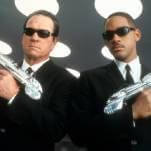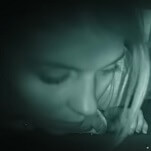Viewers used to the increasing fluidity and visual depth of Hollywood CGI may have trouble getting used to the films of French animator Michel Ocelot, whose features (Kirikou And The Sorceress, Kirikou And The Wild Beast, Princes And Princesses, et al.) operate largely on a two-dimensional plane, as if the characters were shadow puppets moving against a screen. It takes some time with his work to accept that his style is a choice, not a limitation; he’s channeling the early work of animation pioneer Lotte Reiniger, who used backlit paper cutouts to create gloriously detailed mobile silhouettes. And her influence doesn’t end with the visual style: Like her films, Ocelot’s are lavish fairy tales that come from a place of detached, formal reserve, with muted emotions belying the passions that set the characters in motion.
That’s truer than ever with Azur & Asmar, Ocelot’s 2006 fantasy about childhood friends who become rivals on a magical quest. In a visually simple (and excruciatingly slow) opening, the eponymous characters are revealed as infants, both feeding at the breasts of Asmar’s mother, an Arab servant in the household of Azur’s French father. As the story skips forward in time, she raises them as equals, feeding them on Arabic songs and fables about the Djinn Fairy, who rules over the world of the djinns from her prison within a magical mountain. As the boys grow old enough for mischief, Azur’s snobbish, hateful father disapproves of their closeness and abruptly sends Asmar and his mother packing. The boys meet again as adults in Asmar’s homeland, but their former closeness has been replaced by Asmar’s righteous resentment over his exile, and the two youths are separated by race, class, culture, and personal history, not to mention their competitive obsession with finding and freeing the Djinn Fairy.
Like Kirikou And The Sorceress—still Ocelot’s most enjoyable and well-rounded film—Azur & Asmar leavens its default placid solemnity with straight-faced goofiness, as characters whisk around at comical speeds or get into laughable situations. But Azur also ups the visual ante, with a fantastic opulence that increases steadily as the story progresses. The characters themselves look like videogame creations; they move with the lubricated, gimbaled weightlessness of the earliest computer animation, and the attempts to give them painted-on depth often make them look like crude Beowulf prototypes. But they operate within a fantastically detailed world, from the tapestry-like settings to the knotty storyline, which gets as complicated as any chapter of The Arabian Nights. Ocelot’s films won’t replace Pixar’s in anyone’s hearts, but he’s far more interested in doing his own thing: telling richly textured stories in a quaintly traditional way, and making them as beautiful as possible from moment to moment.
Key features: A few trailers.









































